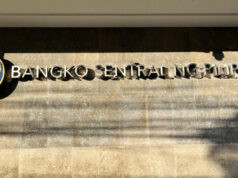Yields on government debt mostly flat

YIELDS on government securities (GS) ended mostly flat last week amid the release of US inflation data that tempered bets of an early rate cut by the US Federal Reserve.
GS yields, which move opposite to prices, went down by an average of 3.77 basis points (bps) week on week at the secondary market, based on the PHP Bloomberg Valuation Service Reference Rates as of March 15 published on the Philippine Dealing System’s website.
The short end of the curve ended mixed, as yields on the 182-, and 364-day Treasury bills (T-bills) declined by 1.68 bps (to 5.9578%) and 8.54 bps (6.0195%), respectively. Meanwhile, the rate of the 91-day T-bill inched up by 0.77 bp (5.7729%)
At the belly, the rates of the two-, three-, four-, five-, and seven-year Treasury bonds (T-bonds) dropped by 8.82 bps (to 6.0257%), 8.8 bps (6.0732%), 8.13 bps (6.1227%), 7 bps (6.166%), and 5.09 bps (6.2123%), respectively.
Meanwhile, yields on the 20- and 25-year debt papers increased by 4.46 bps (to 6.3001%) and 4.71 bps (6.2948%), respectively, while the 10-year debt paper fell by 3.39 bps to fetch 6.2189%.
Total GS volume reached P19 billion on Friday, higher than the P14.13 billion seen on March 8.
A bond trader said in a Viber message that US consumer inflation data affected local yields last week, as these could be considered by the Fed in its meeting this week.
US consumer prices increased solidly in February amid higher costs for gasoline and shelter, suggesting some stickiness in inflation that could delay an anticipated June interest rate cut from the Federal Reserve, Reuters reported.
The consumer price index (CPI) rose 0.4% last month after climbing 0.3% in January, the Labor department’s Bureau of Labor Statistics said on Tuesday. Gasoline and shelter, which includes rents, contributed more than 60% to the monthly increase in the CPI. In the 12 months through February, the CPI increased 3.2%, after advancing 3.1% in January.
Economists polled by Reuters had forecast the CPI gaining 0.4% on the month and increasing 3.1% year on year. The annual increase in consumer prices has slowed from a peak of 9.1% in June 2022, but progress has stalled in recent months.
Prior to the release of the CPI data, financial markets saw a roughly 70% chance of the Fed cutting rates in June. Since March 2022, the US central bank has raised its policy rate by 525 basis points to the current 5.25%-5.5% range.
ATRAM Trust Corp. Vice-President and Head of Fixed Income Strategies Lodevico M. Ulpo, Jr. said last week’s yield movements were mainly driven by the full award of the Bureau of the Treasury’s (BTr) T-bond offer last week.
“Consequently, yields dropped by 4 to 15 bps across the curve, with more pronounced buyer activity, although anticipation for [this] week’s 20-year bond auction caused a lag in long-end yield levels,” he said in an e-mail.
The BTr raised P30 billion as planned via the reissued 10-year bonds it offered on Tuesday as total bids reached P96.071 billion, or more than three times the amount on the auction block.
The bonds, which have a remaining life of nine years and 10 months, were awarded at an average rate of 6.227%, with accepted yields ranging from 6.198% to 6.24%.
“The recent 0.4% increase in the US CPI for February is likely to influence bond market dynamics by encouraging investors to balance reinvesting liquidity from maturing bonds against global inflation trends,” Mr. Ulpo added.
For this week, the Fed’s March 19-20 policy meeting and the 20-year T-bond auction could drive yield movements, he said.
“The prevailing high liquidity levels are anticipated to drive rates lower. However, guidance from the US Federal Reserve, particularly regarding rate cuts, will be crucial. The market is poised to respond to monetary policy signals and reflationary economic data, suggesting a cautious but potentially downward trend in yield levels,” Mr. Ulpo said. — Mariedel Irish U. Catilogo with Reuters



